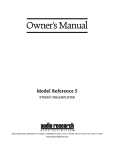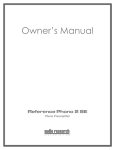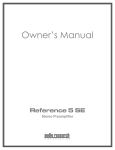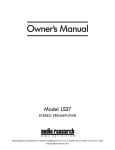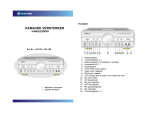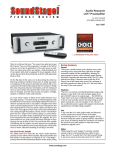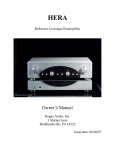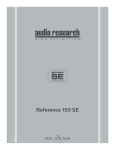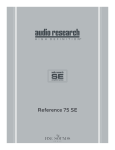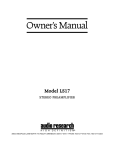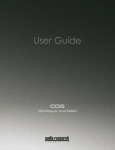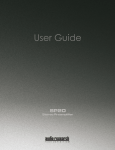Download Audio Research REFERENCE PHONO 10 User guide
Transcript
User Guide REFERENCE PHONO 10 Phono Preamplifier H I G H D E F I N I T I O N® 2 Contents Preface 3 Illustrations Audio Chassis 4 Power Supply Chassis 5 Warnings 6 Installation Installation of Vacuum Tubes 7 In Your System 8 Connections 9 Operation Power-Up Procedure 10 Front Panel Controls 11 Remote Control Only Controls 12 Interactive Touch Screen Operation 13 - 15 Troubleshooting 15 Maintenance Servicing 16 Cleaning 16 Disposal and Recycling Guidelines 16 Limited Warranty 17 Specifications 18 Preface Thank you for selecting the Reference Phono 10 as part of your music listening system. The engineers and designers at Audio Research have spent countless hours of listening and testing to create a preamplifier of the highest caliber for music reproduction. The Reference Phono 10 has been designed to provide you many years of playback. Please take a few minutes to read through this guide to help you better understand and optimize your new preamplifier. If you have any questions regarding the operational functions, contact your dealer or distributor for assistance. Sit back and enjoy your new preamplifier and the enhancements it will bring to your system. The Reference Phono 10 will bring new life to your record collection. Happy listening! 3 4 Illustrations Audio Chassis POWER MUTE FROM POWER SUPPLY CABLE "A" PLYMOUTH, MINNESOTA MADE IN U.S.A. REFERENCE PHONO 10 RIGHT STEREO PHONO PREAMPLIFIER RIGHT LEFT OUTPUT SINGLE ENDED BALANCED RIGHT OUTPUT BALANCED FROM POWER SUPPLY CABLE "B" SINGLE ENDED WARNING INPUT 1 INPUT 2 TURNTABLE GROUND TO PREVENT FIRE AND SHOCK HAZARD, DO NOT EXPOSE THIS DEVICE TO RAIN OR MOISTURE. UNIT MUST BE OPERATED IN A HORIZONTAL POSITION. -DO NOT OPERATE WITH COVERS REMOVEDUNIT CONTAINS VOLTAGES WHICH MAY BE HAZARDOUS. LEFT LEFT CAUTION RISK OF ELECTRIC SHOCK DO NOT OPEN SERIAL ! RS232 5 Illustrations Power Supply Chassis TO AUDIO CHASSIS CABLE "A" PLYMOUTH, MINNESOTA MADE IN U.S.A. REFERENCE PHONO 10 TO AUDIO CHASSIS CABLE "B" STEREO PHONO PREAMPLIFIER WARNING TO PREVENT FIRE AND SHOCK HAZARD, DO NOT EXPOSE THIS DEVICE TO RAIN OR MOISTURE. UNIT MUST BE OPERATED IN A HORIZONTAL POSITION. -DO NOT OPERATE WITH COVERS REMOVEDUNIT CONTAINS VOLTAGES WHICH MAY BE HAZARDOUS. CAUTION ! RISK OF ELECTRIC SHOCK DO NOT OPEN 6A FUSE SLO-BLO T4A (230V) VOLTS SERIAL Remote HOURS POWER REFERENCE PHONO 50 100 200 500 1K 47K CUSTOM INPUT 1 INPUT 2 MUTE LO GAIN HI GAIN DSP DN DSP UP RIAA COLUMBIA CAUTION FOR CONTINUED PROTECTION AGAINST FIRE HAZARD REPLACE FUSE ONLY WITH SAME TYPE AND RATING DECCA 235W MAX 50/60 HZ ~ 6 Warnings To prevent fire, or shock hazard, do not expose your Reference Phono 10 to rain or moisture. This unit contains voltages which can cause serious injury or death. Do not operate with cover removed. Refer servicing to your authorized Audio Research dealer, service center or factory. The detachable power cord on your Reference Phono 10 is equipped with a heavy gauge, 3-conductor cable and a standard three-prong grounding plug. For absolute protection, do not defeat the ground power plug. This provides power line grounding of the Reference Phono 10 chassis to provide absolute protection from electrical shock. For continued protection against fire hazard, replace the fuse only with the same type and rating as specified at the fuse holder. The appliance coupler at the rear of this unit must be accessible for emergency power disconnect. A note about packaging... Save all packaging in a dry place away from fire hazard. Your Reference Phono 10 preamplifier is a precision electronic instrument and should be properly cartoned any time shipment is made. You may not have occasion to return your unit to the factory for service, but if that should prove necessary, or other occasion requiring shipment occurs, the original packaging will protect your Reference Phono 10 from unnecessary damage or delay. 7 Installation Installation of Vacuum Tubes Before operating the Reference Phono 10... This unit has been shipped with the vacuum tubes installed in protective foam in a separate box packed inside the shipping carton. Remove the tubes carefully from the protective foam. Using a phillips-head screwdriver to loosen the fastening screws, remove the top cover and set aside. After removing the top cover and the vacuum tubes packed in protective foam, see the accompanying illustrated sheet (fig. 1 + 2) for instructions on installing the tubes for your Reference 10 in their proper locations in the power supply and audio chassis. Note that the numbers written on each tube correspond to a ‘V’ number printed on the circuit board next to each tube socket. Insert each tube firmly, carefully aligning the tube pins with the corresponding socket holes. TOP VIEW AUDIO UNIT V8 V4 V6 V2 V7 V3 V5 V1 L R fig. 1 V12 L V11 fig. 2 TOP VIEW POWER SUPPLY UNIT V10 V9 R 8 Installation In your System While the Reference Phono 10 does not dissipate an unusual amount of heat, it is important that it be provided with reasonable airflow to assure long, trouble-free operation. In addition, the following installation guidelines will help insure maximum sonic performance as well as reliable service: Operate unit in upright and horizontal position, prefer-ably on solid, nonmetal shelving. Do not stack the preamp on top of a power amplifier: not only could this cause overheating, but hum may be introduced into the preamp from the proximity of the amplifier’s power transformer. Do not stack components or other objects directly on top of the Reference Phono 10. Do not place or operate your preamp on a soft or irregular surface such as a rug. This will prevent proper ventilation. Do not operate your preamp without the top and bottom covers installed. These are required both for safety as well as shielding from interference (except in service operations by qualified personnel). Ensure a minimum of 8-10” clearance above the unit when placed on shelving. Connections Input Connections The Reference Phono 10 offers two sets of RCA input connectors, for connecting multiple turntable/tonearm cables. There is a ground terminal connection adjacent to the RCA input connectors to allow grounding of the turntable(s). Output Connections There is one set of BAL and one set of RCA output connectors for connecting to line inputs (Direct, Aux, Phono, Tuner, etc.) of your linestage/preamplifier. All input/output connectors are gold plated and connect ‘ground’ before ‘hot’. On disconnect, ‘hot’ is disconnected first. Note: A ‘passive’ line stage is not recommended for use with the Reference Phono 10 as it may not provide the gain necessary to amplify the output of the Reference Phono 10 to adequate levels to the power amplifier. It is recommended that all connections be made to the Reference Phono 10 with the power turned ‘off’. 9 10 Operation Power-Up Procedure Secure all rear-panel connections between Reference Phono 10 and the preamplifier. Connect umbilical cables between the Reference Phono 10 Audio and power supply chassis. Twist outer ring to secure. Plug three-prong power cord from rear of chassis into grounded A.C. wall outlet. The Power switch defaults to ’off’ when the unit is plugged into a power receptacle. Press power switch (either remote or front panel). The screen will initially display ‘Now Loading’ for a few seconds, after which it will display the Audio Research logo followed by ‘Reference Phono 10’ (fig. 3 + 4). The main display screen will then appear on the screen, and ‘MUTE’ will be flashing. Once ‘MUTE’ becomes solid, depress the front panel MUTE button (right button) or touch the word ‘MUTE’ on the screen to initiate normal operation. Select input source, then make any other necessary adjustments. fig. 3 fig. 4 Shut-Down • Activate ‘Mute’ function. • Turn off power amplifier(s). • Turn off preamplifier. • Press Reference Phono 10 Power switch to ‘off’. Operation Front Panel Controls The front panel of the audio chassis of the Reference Phono 10 features two buttons, and an interactive touch screen. Power On/Off: (left button) Supplies power from A.C. wall outlet to preamp; indicated by active display window. The Reference Phono 10 requires approximately 40 seconds to warm up; this time is required to stabilize the power supply. See ‘Power-Up Procedure’ on the adjacent page for details. The same cycle also occurs in the event of a power interruption. Mute: (right button) When activated, electrically mutes all output of the phono stage; indicated by ‘Mute’ in display window. This control should be activated before switching inputs, changing connections or shutting down your audio system to help protect your components and speakers from unexpected signal pulses. When deactivated, ‘Mute’ disappears from the display window allowing normal operation. The Reference Phono 10 also has automatic muting to help protect system components during A.C. power interruptions or low line voltage. When sensing these conditions, the preamp automatically goes into ‘Mute’ and disables all outputs. The 40-second warm-up timer will restart and ‘Mute’ will flash in the display window when normal power conditions have been restored. Note that automatic muting is only designed to protect against power line interruptions or severe voltage drop. It will not mute in the event of subsonic transmissions from a faulty input source, component failure or speaker malfunction. 11 12 Operation Remote Only Functions Load (50, 100, 200, 500, 1K, 47K, Custom): Select the appropriate load to match the resistance of your phono cartridge. If not set with a specific value when manufactured, the default value for the Custom setting is 47K (note that the value for the custom setting can be adjusted by Audio Research or an authorized Audio Research service center). Input 1/Input 2: Selects the input for playback. Lo Gain/Hi Gain: Selects the amount of gain for playback. Low Gain offers 51 dB of gain, and is intended for cartidges with high output, usually above 0.5 mV. High Gain offers 74 dB of gain is intended for cartridges below 0.5mV. Display Down/Display Up (DSP DN/DSP UP): Decreases/increases display intensity, offering 6 levels of brightness and display ‘off’. In display ‘off’ mode the display will illuminate for 10 seconds when any button (except Power on/off) is selected, allowing for control function navigation. Equalization Curves (RIAA, COLUMBIA, DECCA): Select between different equalization curves for playback. RIAA equaliztion, introduced in 1954, is the standard with which most records have been produced. During the early era of stereo records, both Columbia and Decca Studios used curves which varied from the RIAA curve. Check the record sleeve for information which may indicate whether your record was recorded using the RIAA curve. Hours: When pressed, displays number of hours vacuum tubes have been in service. Note: After replacing tubes, this function should be reset to ‘0’. See further instructions under ‘Hours Meter’ in the section ‘Interactive Touch Screen Operation’ for details. Operation Interactive Touch Screen Operation The Reference Phono 10 has been designed with a 7” interactive touch screen for reliable and easy usage. The interface is programmed so that the desired item for change simply needs to be touched to either toggle between functions, or bring up a secondary menu for function selection. Input Selection: To change inputs, touch the currently displayed input name on the screen. The input bar will appear, listing both input options. Touch the desired input to change (fig. 5). fig. 5 Equalization, Load, Gain: To change any of these functions, touch the word you wish to affect and it will toggle between the different options for each category (fig. 6). fig. 6 Mute/Operate: Toggle mute on and off by touching the screen where ‘MUTE’ or ‘OPERATE’ is displayed. You may also use the right button beneath the rotary control to toggle between mute and operate. 13 14 Operation SETTINGS MENU Touching the settings icon located in the bottom right of the screen (it appears as a gear) brings you to a submenu with different options related to the setup and functionality of the Reference Phono 10 (fig. 7). fig. 7 Input Names: Selecting Input Names will allow you to customize the names of each input on the Reference Phono 10. Once selected, the input bar will appear at the top of the screen with an alphanumeric keyboard below it. To change the name of any input, simply touch the input until it is highlighted and type in the new name. When input naming is complete, select ‘DONE’ to go back to the settings menu. Tube Hours: The Hours Meter displays the total number of hours the Reference Phono 10 has been running. This is useful to gauge tube life and prepare for eventual replacement. The hours meter may be reset after the tubes have been changed by touching the ‘Reset’ button located in the bottom right of the screen. About: Touching the ‘About’ button displays a screen with the current software version of the Reference Phono 10. This information can be useful in the event the Reference Phono 10 needs troubleshooting. In the bottom right of the About screen is a ‘Defaults’ button. Selecting the defaults button will return all settings in the Reference 10 as they were shipped from the factory. Note: Resetting the Reference Phono 10 back to factory settings does NOT reset the hours meter. Operation Foreground/Background Color: The Reference Phono 10 has ten color options for both screen background and text. Selecting either one of these options from the settings menu will allow you choose a new color to customize the display on your Reference Phono 10. Please note that the currently selected color is not displayed in the choices shown, nor do you have the option to choose the same color for both the background and foreground (fig. 8). fig. 8 Display Intensity: Display Intensity adjusts the backlight for the screen and its overall brightness. There are six levels plus ‘off’, with ‘6’ being the brightest. When ‘off’ is selected, the display will remain on for 8 seconds and then shut off. To return illumination to the screen, simply touch it or press a button on the remote. When adjusting the brightness, the words ‘Display Intensity’ will reflect the overall setting seleted. The display intensity can also be adjusted from the remote using the ‘DSP UP’ and ‘DSP DN’ buttons. Troubleshooting It is possible for a static discharge to temporarily disable the microprocessor that allows the controls to function. If this should occur, depress the ‘Mute’ button, then turn off the preamp and unplug the preamp from the A.C. receptacle for 60 seconds. Reconnect the A.C. plug and turn the preamp back on, along with other components. The controls should resume normal operation. If the problem persists, contact your dealer or Audio Research Customer Service at 763-577-9700. 15 16 Maintenance Servicing CAUTION: Your Reference Phono 10 contains sufficient levels of voltage and current to be lethal. Do not tamper with a component or part inside the unit. Refer any needed service to your authorized Audio Research dealer or other qualified technician. The vacuum tubes inside your Reference Phono 10 are quality tubes and with normal use should offer approximately 2,000 hours of use for the 6550 and 4,000 hours for the 6H30. Replacement tubes should be of equivalent quality and are available from Audio Research. Note that tube numbers (V1, V2 etc.) match printed numbers next to tube sockets on circuit board. Should service be necessary, please contact your Audio Research dealer, or Audio Research Customer Service at 763-577-9700 or service@ audioresearch.com. Cleaning To maintain the new appearance of this unit, occasionally wipe the front panel and top cover with a soft, damp (not wet) cloth to remove dust. A mild, non-alkaline soap solution may be used to remove fingerprints or similar smudges. Cleaners containing abrasives should not be used as they will damage the anodized finish of the front panel. A small, soft paintbrush is effective in removing dust from bevels, the recessed nameplate and other features of the front panel. Disposal and Recycling Guidelines To dispose of this electronic product, do not place in landfill. In accordance with the European Union Waste Electrical and Electronic Equipment (WEEE) directive effective August 2005, this product may contain regulated materials which upon disposal require special reuse and recycling processing. Please contact your dealer or importing distributor for instructions on proper disposal of this product in your country. Or, contact Audio Research Corporation (763-577-9700) for the name of your importing distributor and how to contact them. Packing and shipping materials may be disposed of in a normal manner. Limited Warranty Audio Research Corporation products are covered by a 3-Year Limited Warranty, or a 90-Day Limited Warranty (vacuum tubes). This Limited Warranty initiates from the date of purchase, and is limited to the original purchaser, or in the case of demonstration equipment, limited to the balance of warranty remaining after original shipment to the retailer or importer. In the United States, the specific terms, conditions and remedies for fulfillment of this Limited Warranty are listed on the warranty card accompanying the product in its shipping carton, or may be obtained from the authorized retailer or from the Audio Research Customer Service Department. Outside the United States, the authorized importing retailer or distributor has accepted the responsibility for warranty of Audio Research products sold by them. The specific terms and remedies for fulfillment of the Limited Warranty may vary from country to country. Warranty service should normally be obtained from the importing retailer or distributor from whom the product was purchased. In the unlikely event that technical service beyond the ability of the importer is required, Audio Research will fulfill the terms and conditions of the Limited Warranty. Such product must be returned at the purchaser’s expense to the Audio Research factory, along with a photocopy of the dated purchase receipt for the product, a written description of the problem(s) encountered, and any information necessary for return shipment. The cost of return shipment is the responsibility of the purchaser. 17 18 Specifications Frequency Response: ± .2dB of RIAA, 10Hz to 60kHz; 3dB points below 0.3Hz and above 300kHz. Distortion: Less than .002% at 1.0V RMS 1kHz output. Gain: Selectable 51dB (Low), 74dB (High) at1kHz BAL; 45dB (Low), 68dB (High) at1kHz SE. (MC & MM compatible). Buttons: Front (2) Power, Mute Input Impedance: 47K ohms and 100pF SE. Selectable loads: 1000, 500, 200, 100, 50 ohms and Custom. Phono Equalization: (Selectable) RIAA, Columbia, Decca. Output Polarity: Non inverting. Output Impedance: 200 ohms SE, 400 ohms balanced. Recommended load 50K-100K ohms and 100pF. (10K ohms minimum and 2000pF maximum.) Maximum Input: 250mV RMS at 1kHz (680 mV RMS at10kHz). Rated Outputs: 0.5V RMS 10Hz to 20kHz, 100K ohm load (output capability is 80V RMS BAL output at 1/2% THD at1kHz, 40V SE.) Power Supplies: Electronically regulated low and high voltage supplies. Automatic 40 sec. warm-up/brown-out mute. Line regulation better than .01%. Noise: 0.22uV equivalent input noise, IHF weighted, shorted(Low Gain) input (73 dB below 1mV 1kHz input). 0.055uV equivalent input noise (High Gain) (65dB below 0.1mV 1kHz input) Tube Complement: (8)-6H30P dual triodes, plus (2 each) 6550C and 6H30P in power supply. Power Requirements: 100-135VAC 60Hz (200-270VAC 50/60Hz) 235 watts maximum. Standby: 0.8 watts. Dimensions: Width 19” (48 cm) Height 7” (17.8 cm) (standard rack panel) Depth 15.5” (39.4 cm) Handles extend 1.5” (3.8 cm) forward of the front panels. Weight: Audio Chassis: 22 lbs. (10 kg) Net; 34 lbs. (15.5 kg) Shipping. Power Supply Chassis: 35 lbs. (15.9 kg) Net; 43 lbs. (19.5 kg) Shipping. This unit is RoHS compliant H I G H D E F I N I T I O N® a member of Specifications subject to change without notice. ©2013 Audio Research Corporation.


















